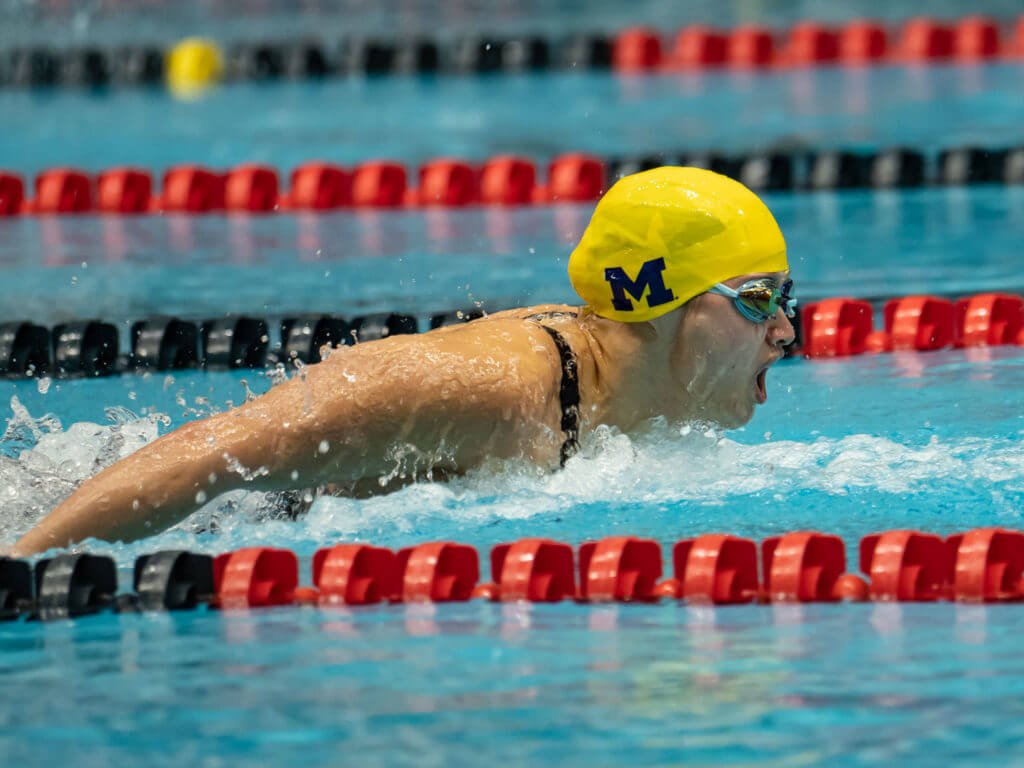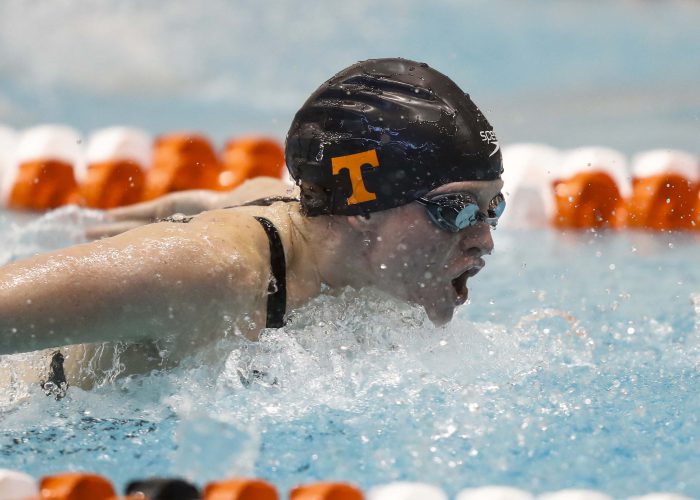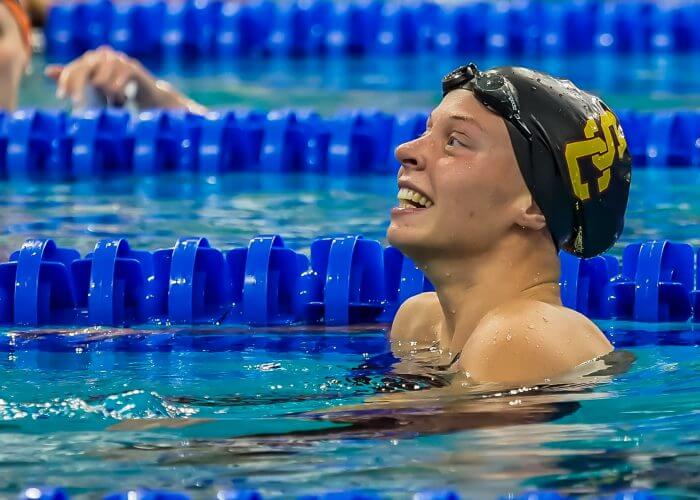Analyzing the Growth of the Women’s 100 Fly and the Race We Never Saw

Analyzing the Growth of the Women’s 100 Fly and the Race We Never Saw
At the 2002 NCAAs in Austin, Cal sophomore Natalie Coughlin put on one of the most impressive meets in NCAA history, winning the 100 and 200 back and the 100 fly with American records in each race. All three of her records stood the test of time, with the 200 back record of 1:49.52 falling seven years later. Her 100 fly record of 50.01 would last until 2015 while her 100 back record stood the longest: her 49.97 endured until 2017.
Coughlin’s 100 fly lasted for 13 years when Kelsi Worrell of Louisville slammed through the heats with a 49.89, becoming the first woman to break 50 seconds in the event. Later on in finals, she went even faster at 49.81, and as a senior in 2016 she lowered it again to 49.43 in the finals of the event.
In the years since Worrell’s swim, the 100 butterfly really took off but we may not know how fast it really could have been.

Erika Brown. Photo Courtesy: John Golliher/Tennessee Athletics
In 2018, Tennessee sophomore Erika Brown joined Worrell in the sub-50 club with a 49.85 at SECs. Weeks later, USC sophomore Louise Hansson won the NCAA title with a 49.80. It wasn’t a record, but it was the second fastest time ever, and a rivalry looked to be budding between her and Brown, who was a rising star at the time. They had two more years to duel at the NCAA level. How far could they take the record down, and would anyone else join them in the sub-50 club?
In the fall of 2018, Michigan freshman Maggie MacNeil had put up some insane times in dual meets, indicating that she was in for a breakout year and could potentially challenge for the national title. Throughout the season, she had consistently been under 51 seconds, registering a 49.59 at the Big Ten Championships. Hansson was the top seed going into NCAAs with a 49.34. Brown was again a 49.85 from SECs, and Cal senior Katie McLaughlin had been lingering in as the fourth seed.
It was expected a 48 would win the final of the 100 fly at the 2019 NCAAs and it was just a matter of who would take the mantle as the first woman to break 49 seconds? Any of the top four women could come out on top and it was a race many were anticipating to be one of the all-timers.
On that day, the race took priority over the time – Hansson still set the US Open record with a 49.26, but it was a bit underwhelming and the race didn’t seem as exciting as previously predicted. MacNeil was second at 49.66 with McLaughlin third at 49.97, becoming the fourth under 50 seconds, lowering Coughlin’s Cal school record in the process. Brown was fourth at 50.38.
It was the fastest field ever assembled in the 100 butterfly, with four of the top five performers all-time side by side in the very same pool that Coughlin broke the American record that stood for so long.
Even if it was “underwhelming,” the 100 butterfly had taken off.
A few weeks before NCAAs, high school junior Olivia Bray swam a 50.19 in a low-key club meet in Virginia. What seemed like an unattainable standard of 50.01 was now within reach for so many women. So how did we get here?
Women’s 100 butterfly eighth place prelims times with winning times from last 10 years:
- 2019: 51.27 – 49.26
- 2018: 51.57 – 49.80
- 2017: 51.45 – 50.05
- 2016: 51.58 – 49.43
- 2015: 51.86 – 49.81
- 2014: 51.78 – 50.89
- 2013: 52.25 – 51.64
- 2012: 52.31 – 51.49
- 2011: 52.58 – 50.49
- 2010: 52.41 – 51.43
Obviously when one person breaks through with a record like Worrell’s, it inspires other people to believe they can do the same. When one person breaks down a barrier, it draws other people to believe anything is possible.

Louise Hansson. Photo Courtesy: Peter H. Bick
It is also no secret that butterfly is a stroke synonymous with power. One needs to have a good catch and a good kick in order to be a good butterflyer – and Worrell showcased immense power with her stroke, and was also a very strong underwater kicker. The 100 butterfly has not necessarily changed in the last 10 years like the 200 breast or 50 free, but strength training has definitely changed.
Women are more encouraged nowadays to have strong bodies with more muscle, contrary to generations ago in the 70s and 80s. Girls are starting to lift at younger ages so when they get to college, they already have a good base under their belt when they step into the weight room. That has for sure changed the 100 butterfly as an event for women, and the times have shown.
Heading into the 2019-20 season, six of the eight finalists were returning, including Hansson, MacNeil and Brown. Over the summer, MacNeil had shocked the world in becoming the world champion in the 100 butterfly, while Hansson had a big breakthrough and also reached the final at the World Championships.
In December 2019, MacNeil matched Hansson’s NCAA and US Open record with a 49.26 at the Minnesota Invite, setting up an anticipated matchup in March. By SECs, Brown re-established herself as a favorite, breaking Worrell’s American record at 49.38. A day later, Virginia freshman Kate Douglass won the ACC title with a 50.83, a little off her 50.30 from the Tennessee Invite, but she was also a dark horse for the national title and among the contenders.
When the psych sheets came out, MacNeil, Brown, Hansson and Douglass were all slated to race the 100 fly – with Brown choosing the 100 fly over the 200 free where she had a good shot of winning that event for Tennessee.
Leading into the 2020 NCAAs, the 100 fly was expected to be a race for the ages. So when the meet was unfortunately cancelled due to the rising COVID-19 pandemic a week before the meet was due to take place, fans would never get a chance to see the best of the best race alongside each other in this circumstance. It was a heartbreaking for all involved, especially the seniors who invested so much time and energy into one last shot at representing their school on the national stage.
We don’t want to make predictions about who would have won the race – but it was almost for certain that it would take an NCAA record to win. How fast they would have gone would remain a mystery. Would MacNeil follow up her 2019 World title with a record setting performance to gain some momentum for the Olympics? Would Hansson win her third straight national title and cement her legacy as one of the top NCAA flyers of all-time? Would Brown finally break through to win her first individual national title? Or would Douglass surpass all expectations and win it all as a freshman?
We will never know the answers to those questions, but we do know that the women’s 100 fly has seen a big boost in improvement over the last few years, thanks in part to Coughlin, Worrell, and the increasing number of women – rising star Claire Curzan included – stepping up to break 50 seconds in the event.



